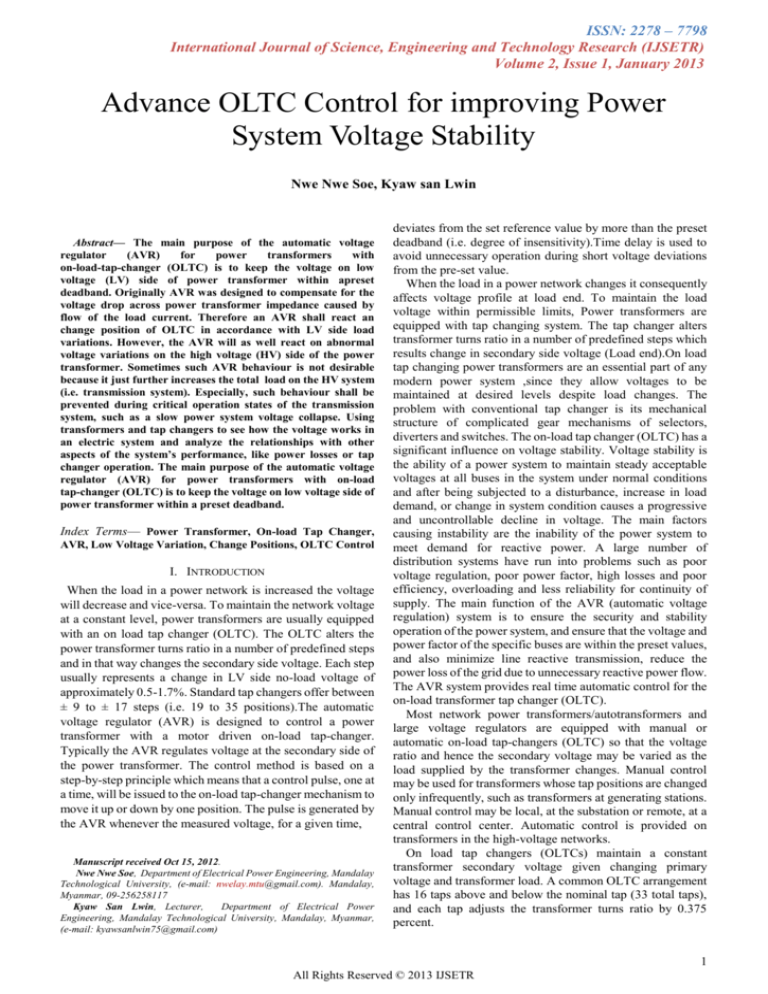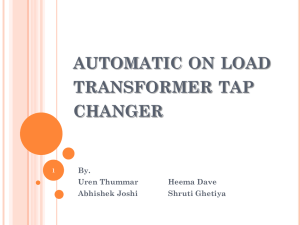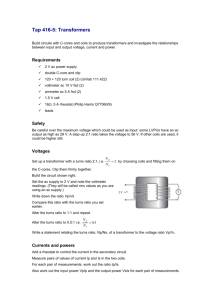
ISSN: 2278 – 7798
International Journal of Science, Engineering and Technology Research (IJSETR)
Volume 2, Issue 1, January 2013
Advance OLTC Control for improving Power
System Voltage Stability
Nwe Nwe Soe, Kyaw san Lwin
Abstract— The main purpose of the automatic voltage
regulator
(AVR)
for
power
transformers
with
on-load-tap-changer (OLTC) is to keep the voltage on low
voltage (LV) side of power transformer within apreset
deadband. Originally AVR was designed to compensate for the
voltage drop across power transformer impedance caused by
flow of the load current. Therefore an AVR shall react an
change position of OLTC in accordance with LV side load
variations. However, the AVR will as well react on abnormal
voltage variations on the high voltage (HV) side of the power
transformer. Sometimes such AVR behaviour is not desirable
because it just further increases the total load on the HV system
(i.e. transmission system). Especially, such behaviour shall be
prevented during critical operation states of the transmission
system, such as a slow power system voltage collapse. Using
transformers and tap changers to see how the voltage works in
an electric system and analyze the relationships with other
aspects of the system’s performance, like power losses or tap
changer operation. The main purpose of the automatic voltage
regulator (AVR) for power transformers with on-load
tap-changer (OLTC) is to keep the voltage on low voltage side of
power transformer within a preset deadband.
Index Terms— Power Transformer, On-load Tap Changer,
AVR, Low Voltage Variation, Change Positions, OLTC Control
I. INTRODUCTION
When the load in a power network is increased the voltage
will decrease and vice-versa. To maintain the network voltage
at a constant level, power transformers are usually equipped
with an on load tap changer (OLTC). The OLTC alters the
power transformer turns ratio in a number of predefined steps
and in that way changes the secondary side voltage. Each step
usually represents a change in LV side no-load voltage of
approximately 0.5-1.7%. Standard tap changers offer between
± 9 to ± 17 steps (i.e. 19 to 35 positions).The automatic
voltage regulator (AVR) is designed to control a power
transformer with a motor driven on-load tap-changer.
Typically the AVR regulates voltage at the secondary side of
the power transformer. The control method is based on a
step-by-step principle which means that a control pulse, one at
a time, will be issued to the on-load tap-changer mechanism to
move it up or down by one position. The pulse is generated by
the AVR whenever the measured voltage, for a given time,
Manuscript received Oct 15, 2012.
Nwe Nwe Soe, Department of Electrical Power Engineering, Mandalay
Technological University, (e-mail: nwelay.mtu@gmail.com). Mandalay,
Myanmar, 09-256258117
Kyaw San Lwin, Lecturer,
Department of Electrical Power
Engineering, Mandalay Technological University, Mandalay, Myanmar,
(e-mail: kyawsanlwin75@gmail.com)
deviates from the set reference value by more than the preset
deadband (i.e. degree of insensitivity).Time delay is used to
avoid unnecessary operation during short voltage deviations
from the pre-set value.
When the load in a power network changes it consequently
affects voltage profile at load end. To maintain the load
voltage within permissible limits, Power transformers are
equipped with tap changing system. The tap changer alters
transformer turns ratio in a number of predefined steps which
results change in secondary side voltage (Load end).On load
tap changing power transformers are an essential part of any
modern power system ,since they allow voltages to be
maintained at desired levels despite load changes. The
problem with conventional tap changer is its mechanical
structure of complicated gear mechanisms of selectors,
diverters and switches. The on-load tap changer (OLTC) has a
significant influence on voltage stability. Voltage stability is
the ability of a power system to maintain steady acceptable
voltages at all buses in the system under normal conditions
and after being subjected to a disturbance, increase in load
demand, or change in system condition causes a progressive
and uncontrollable decline in voltage. The main factors
causing instability are the inability of the power system to
meet demand for reactive power. A large number of
distribution systems have run into problems such as poor
voltage regulation, poor power factor, high losses and poor
efficiency, overloading and less reliability for continuity of
supply. The main function of the AVR (automatic voltage
regulation) system is to ensure the security and stability
operation of the power system, and ensure that the voltage and
power factor of the specific buses are within the preset values,
and also minimize line reactive transmission, reduce the
power loss of the grid due to unnecessary reactive power flow.
The AVR system provides real time automatic control for the
on-load transformer tap changer (OLTC).
Most network power transformers/autotransformers and
large voltage regulators are equipped with manual or
automatic on-load tap-changers (OLTC) so that the voltage
ratio and hence the secondary voltage may be varied as the
load supplied by the transformer changes. Manual control
may be used for transformers whose tap positions are changed
only infrequently, such as transformers at generating stations.
Manual control may be local, at the substation or remote, at a
central control center. Automatic control is provided on
transformers in the high-voltage networks.
On load tap changers (OLTCs) maintain a constant
transformer secondary voltage given changing primary
voltage and transformer load. A common OLTC arrangement
has 16 taps above and below the nominal tap (33 total taps),
and each tap adjusts the transformer turns ratio by 0.375
percent.
1
All Rights Reserved © 2013 IJSETR
ISSN: 2278 – 7798
International Journal of Science, Engineering and Technology Research (IJSETR)
Volume 2, Issue 1, January 2013
When the transformer's secondary voltage is outside the
permitted margin, thus motors change the tap position and
regulate secondary voltage while still supplying the load. An
OLTC control measures the secondary voltage and sends raise
and lower signals to the OLTC motor to control secondary
voltage.
The OLTCs interact with each other whenever there is a
voltage deviation on the system. Traditionally, each voltage
level is graded with the next, using simple time delays. This
ensures that the upstream tap changers take priority over the
downstream units and make their tap changes first. This
prevents hunting and reverse actions by lower-level tap
changers. Unfortunately, the voltage control can become
crude and inefficient at small voltage deviations. The new
control strategies have been developed to improve the
coordination of the AVR system and hence provide an
improved quality of supply for consumers.
II. VOLTAGE CONTROL WITH ON-LOAD TAP-CHANGER
The ratio of a transformer can be changed by adding turns
to or subtracting turns from either the primary or the
secondary winding using a load tap-changer (LTC). The LTC
can be located at the primary or the secondary side of the
transformer. The representation of a transformer equipped
with an LTC and its equivalent diagram is shown in Figure .1.
Notation I, U, n and y in the figure indicates current, voltage,
normalization of the transformer turn ratio and transformer
admittance, respectively; and subscripts p and s indicate
primary and secondary sides of the transformer, respectively.
This paper will only deal with OLTC that has been widely
used in voltage regulation for many decades. The OLTC basic
arrangement is shown in Figure 2. The OLTC controller keeps
the substation secondary bus voltage U1 constant within the
range
ULB < U1 < UUB (3-4)
Where,
ULB = Uset – 0.5UDB is the lower boundary voltage
UUB = Uset + 0.5UDB is the upper boundar
Uset is the set point voltage and UDB is the deadband.
III. OLTC SWITCHING SEQUENCE
In oil-type OLTCs there are two types of switching
principles used, the diverter which consists of an arcing
switch and a tap selector, and the selector which consists of an
arcing tap switch [1]. Diverter type OLTCs change taps in two
steps: “First, the next tap is pre-selected by the tap selector at
no load (Then the arcing switch transfers the load current
from the tap in operation to the pre-selected tap” [1]. The tap
selector is operated directly by the OLTC drive mechanism,
whereas the arcing switch is operated by a stored energy
spring.
Figure 1. OLTC representation and its equivalent diagram
There are two types of LTC, no-load tap-changer where the
transformer ratio can be changed only when the transformer is
de-energized, and on-load tap-changer (OLTC) where
changing of the tap position is possible also when the power
transformer is carrying load.
Figure 2. Basis OLTC arrangement
Figure 3. LTC representation and its equivalent diagram
IV. AUTOMATIC OLTC CONTROL PRINCIPLES FOR SINGLE
TRANSFORMER
A typical AVR measures the busbar voltage (UB) at the
power transformer LV side, and if no other additional features
are enabled (i.e. line drop compensation) this voltage is used
for voltage regulation. The voltage control algorithm then
compares UB with the set target voltage (Uset) and decides
which action should be taken.
Because this control method is based on a step-by-step
introduced in order to avoid unnecessary switching around the
target voltage. The deadband is typically symmetrical around
Uset as shown in Figure 4. Deadband should be set to a value
close to the power transformer.s OLTC voltage step. Typical
setting is 75% of the OLTC step.
2
All Rights Reserved © 2013 IJSETR
ISSN: 2278 – 7798
International Journal of Science, Engineering and Technology Research (IJSETR)
Volume 2, Issue 1, January 2013
During normal operating conditions the busbar voltage UB,
stays within the deadband. In that case no actions will be taken
by the AVR. However, if UB becomes smaller than U1 or
greater than U2 (see Figure 4), an appropriate lower or raise
timer will start. The timer will run as long as the measured
voltage stays outside the inner deadband. If this condition
persists for longer than a preset time, the appropriate LOWER
or RAISE command will be issued. If necessary, the
procedure will be repeated until the busbar voltage is again
within the inner deadband. The main purpose of the time
delay is to prevent unnecessary OLTC operations due to
temporary voltage fluctuations. The time delay may also be
used for OLTC co-ordination in radial distribution networks
in order to decrease the number of unnecessary OLTC
operations. This can be achieved by setting a longer time
delay for AVRs located closer to the end consumer and
shorter time delays for AVRs located at higher voltage levels.
Figure 4. Typical AVR Voltage Scale for automatic voltage control
V. SELECTION OF LOAD TAP CHANGER
The selection of a particular OLTC will render optimum
technical and economic efficiency if requirements due to
operation and testing of all conditions of the associated
transformer windings are met. In general, usual safety margins
may be neglected as OLTCs designed, tested, selected and
operated in accordance with IEEE and IEC standards are most
reliable.
To select the appropriate OLTC the following important
data of associated transformer windings should be known:
MVA-rating
Connection of tap winding (for wye, delta or single-phase
connection)
Rated voltage and regulating range
Number of service tap positions
Insulation level to ground
Lightning impulse and power frequency voltage of the
internal insulation [1]
The following OLTC operating data may be derived from
this information:
Rated through-current: Iu
Rated step voltage: Ui
Rated step capacity: Pst = Ui × Iu and the appropriate tap
changer can be determined:
OLTC type
Number of poles
Nominal voltage level of OLTC
Tap selector size/insulation level
Basic connection diagram
If necessary, the following characteristics of the tap changer
should be checked:
Breaking capacity
Overload capability
Short-circuit current (especially to be checked in case of
phase shifting applications)
Contact life [3]
VI. SIMULATION MODEL OF OLTC REGULATING
TRANSFORMER
In this design, three-phase two winding 230/33 kV, 85
MVA OLTC regulating power transformer is used for electric
arc furnace. This OLTC transformer connections are high
voltage Y-ground (Yg) and low voltage delta. The on-load tap
changer (OLTC) uses a tap winding (regulating winding) in
series with winding 1(Yg) to vary the U1 voltage in 16 deltaU
steps from tap -8 to +8 (17-positions). Tap position 0 to
correspond to nominal voltage ratio.
The transformer voltage ratio U2/U1 (p.u) is given by:
U2/U1 = 1/(1 + Tap position × deltaU)
Where: -8 ≤ Tap position ≤ +8
In automatic mode, (voltage regulator ‘on’), the signal
applied at the Vm input is monitored and the voltage regulator
asks for a tap change if:
abs (Vm – Vref) >deadband/2 during a time t > delay
Voltage step deltaU per tap = 0.01875 p.u
Initial tap position = -4
Tap selection time = 3 ~ 10 s
Tap transient time = 40 ~ 60 ms
Transfer resistance = 5 ohm
Voltage regulator = ‘on’ mode
Vref= 1.04 p.u
DeltaU = 0.0375 p.u
Delay time = 1 s
VII. BLOCK MODEL OF OLTC REGULATING TRANSFORMER
This model is a three-phase two-winding power transformer
using a on-load tap changer (OLTC) for regulating voltage on
a transmission or distribution system.
Controlling voltage on a transmission system will affect
primarily flow of reactive power, which, in turn, will affect
the power transfer limits. Although the regulating transformer
does not provide as much flexibility and speed as
power-electronics based FACTS, it can be considered as a
basic power flow controller. This is why it has been included
in the facts library. The dynamic performance of the
regulating transformer can be enhanced by using a
thyristor-based tap changer instead of a mechanical tap
changer. As this model is a phasor model which does not
implement the details of current commutation from one tap to
the next tap, can be use it to model a thyristor-based tap
changer.
Figure 5. Block Model of Three-phase Two-winding Transformer
The regulating transformer is usually associated with a
control system which regulates voltage at the transformer
terminals (side 1 or side 2) or at a remote bus. Such a control
system is provided in the Three-Phase OLTC Regulating
Transformer (Phasor Type) block. Then connect at the
Vminput of the block a simulink signal which is usually the
magnitude of the positive-sequence voltage (in pu) to be
3
All Rights Reserved © 2013 IJSETR
ISSN: 2278 – 7798
International Journal of Science, Engineering and Technology Research (IJSETR)
Volume 2, Issue 1, January 2013
controlled, but it can be any signal. The control system will
adjust automatically the tap position until the measured
voltage Vm is equal to the reference voltage Vref specified in
the block menu. The voltage regulator is a hysteresis type
regulator. Each time a tap change is required, the regulat
sends a pulse either to the Up or Down input of the Tap
Changer Controller. Look under the block mask to see how
these control blocks are built. The regulator will ask for a tap
change if
|Vm – Vref| >Deadband/2 during a time t > Delay
Where: Vref, Deadband, and Delay are parameters of the
voltage regulator.
For the automatic voltage regulation, the winding is
designed to adopt an OLTC. Typically the automatic voltage
regulator (AVR) regulates voltage at the secondary side of the
power transformer. The control method is based on a
step-by-step principle. That is, a control pulse, one at a time,
will be issued to the on load tap changing mechanism to move
OLTC up or down by one step position. The connecting tap
points of the windings for tap change can cause a thermal
problem. Therefore, the tap selecting part of OLTC
equipment was installed into the liquid nitrogen and the other
parts were installed at room temperature as the conventional
transformer did.
Tap positions, high voltage (pink color) and low voltage
(yellow color) p.u conditions, active power (MW) and
reactive power (MVar) from high voltage side are also shown
in the result Figures.
Figure 8. Simulation Results of OLTC Transformer for 30 MW and 5 Mvar
Load
(a)Voltage Signal
Figure 9. Simulation of OLTC Transformer for 7 MW and 3.5 Mvar Load
(b) Active and Reactive Power Signal
Figure 6. Signal Processing Block Diagram of OLTC Regulating
Transformer
VIII. SIMULATION OF OLTC REGULATING TRANSFORMER
For installing tap points on the primary winding, Simulink
model and simulation results are shown in the following
Figures.
Figure 7. Simulation of OLTC Transformer for 30 MW and 5 Mvar Load
Figure 10. Simulation Results of OLTC Transformer for 7 MW and 3.5 Mvar
Load
4
All Rights Reserved © 2013 IJSETR
ISSN: 2278 – 7798
International Journal of Science, Engineering and Technology Research (IJSETR)
Volume 2, Issue 1, January 2013
implementation of the vacuum switching technology in
OLTCs provides the best formula of quality, reliability and
economy achievable towards a maintenance free design. The
vacuum switching technology entirely eliminates the need for
an on-line filtration system and offers reduced down-times
with increased availability of the transformer and simplified
maintenance logistics. All these together translate into
substantial savings for the end-user.
ACKNOWLEDGEMENT
Figure 11. Simulation of OLTC Transformer for 4 MW and 2 Mvar Load
The author wishes to express her deepest gratitude to her
teachers, Department of Electrical Power Engineering,
Mandalay Technological University. Similar thanks to all for
their instructions and willingness to share their ideas
throughout all those years of study.
REFERENCES
[1]
[2]
[3]
[4]
[5]
[6]
[7]
[8]
Dr. Dieter Dohnal, “on-load Tap-changers for Power Transformers”,
MR knowledge base, Maschinenfabrik Reinhausen GmbH in
Regensburg, Germany, www.reinhausen.com (2013).
Hans Linder, “On-load Tap Changer, Type UC, Technical Guide”,
Power and productivity, ABB AB Components, SE-771 80
LUDVIKA, Sweden,(2012).
ABB Elektrik Sanayi A.S., “Power Transformers”: Reference and
application, Turkey, www.abb.com/tr (2011).
Dr. J. J. Smith, “On-load Tap Changer Diagnosis on High-Voltage
Power Transformers using Dynamic Resistance Measurements”,
Technische Universiteit Delft, Switzerland, (2011).
ABB, “Liquid Filled Power Transformers”, Power and productivity,
Poland, www.abb.com (2009).
Dieter Dohnal, “On-Load Tap-Changers for Power Transformers”, A
Technical Digest, MR Publication, (2004).
ABB, “Oil-type Distribution Transformers”: ABB Power Technology
Products, Switzerland, www.abb.com (2001).
Siemens Energy, “Transformers”, Power Engineering Guide, Edition
7.0, www.siemens.com/energy/transformers (No Date).
Figure 12. Simulation Results of OLTC Transformer for 4 MW and 2 Mvar
Load
In this simulation models, OLTC changes the power
transformer’s turns ratio in a number of predefined steps and
the secondary voltage is changed by this. Each step usually
represents a change of ±1.25 % in low voltage side. Figure (i)
shows the tap changing positions in high voltage winding
respect with the secondary load changes. H.V winding of
power transformer is changed 230500/√3 ± 8×1.25% (17
positions) in each step changes ± 2881 V. In Figure (ii), low
voltage (p.u) is stable from 50 ms at complex load and high
voltage changes with respectively turn ratio. Active power
(MW) and reactive power (MVar) conditions are also shown
in Figure (iii) and (iv).
IX. CONCLUSION
This paper was intended for sample simulation results of
OLTC regulating transformer. OLTC theory, operation and
example application with Steel Mill are also described in this
paper. This research is carried out using MATLAB programs
performed on 17-taps OLTC transformer and then the
simulation results show the effects of varying tap ratio by
using tap changing transformer. Presently available technical
solutions enable the production of OLTCs that are reliable
and meet the same life expectancy as transformers. At the
present time and for the foreseeable future, the proper
5
All Rights Reserved © 2013 IJSETR







